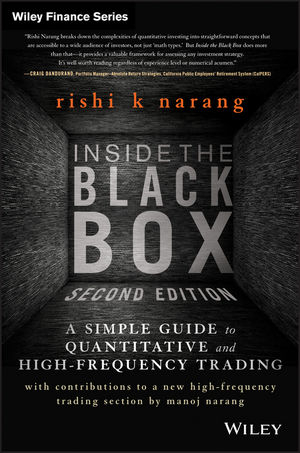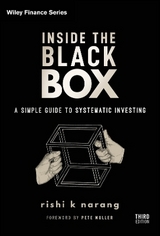
Inside the Black Box
John Wiley & Sons Inc (Verlag)
978-1-118-36241-9 (ISBN)
- Lieferbar
- Versandkostenfrei
- Auch auf Rechnung
- Artikel merken
New edition of book that demystifies quant and algo trading In this updated edition of his bestselling book, Rishi K Narang offers in a straightforward, nontechnical style—supplemented by real-world examples and informative anecdotes—a reliable resource takes you on a detailed tour through the black box. He skillfully sheds light upon the work that quants do, lifting the veil of mystery around quantitative trading and allowing anyone interested in doing so to understand quants and their strategies. This new edition includes information on High Frequency Trading.
Offers an update on the bestselling book for explaining in non-mathematical terms what quant and algo trading are and how they work
Provides key information for investors to evaluate the best hedge fund investments
Explains how quant strategies fit into a portfolio, why they are valuable, and how to evaluate a quant manager
This new edition of Inside the Black Box explains quant investing without the jargon and goes a long way toward educating investment professionals.
rishi k narang is the Founding Principal of T2AM LLC, which invests in quantitative strategies. He has been involved in the hedge fund industry variously as an investor in and practitioner of quantitative trading strategies since 1996. When he isn’t working, Rishi enjoys playing his guitar, writing essays and poems, making pencil sketches, arguing with people, playing tennis, doing yoga, and hiking. Rishi completed his undergraduate degree in economics at the University of California at Berkeley. He lives in Los Angeles with his wife, Dr. Carolyn Wong, and their son, Solomon.
Preface to the Second Edition xiii
Acknowledgments
Part One The Quant Universe
Chapter 1 Why Does Quant Trading Matter? 3
The Benefit of Deep Thought 8
The Measurement and Mismeasurement of Risk 9
Disciplined Implementation 10
Summary 11
Notes 11
Chapter 2 An Introduction to Quantitative Trading 13
What Is a Quant? 14
What Is the Typical Structure of a Quantitative Trading System? 16
Summary 19
Notes 20
Part Two Inside the Black Box
Chapter 3 Alpha Models: How Quants Make Money 23
Types of Alpha Models: Theory-Driven and Data-Driven 24
Theory-Driven Alpha Models 26
Data-Driven Alpha Models 42
Implementing the Strategies 45
Blending Alpha Models 56
Summary 62
Notes 64
Chapter 4 Risk Models 67
Limiting the Amount of Risk 69
Limiting the Types of Risk 72
Summary 76
Notes 78
Chapter 5 Transaction Cost Models 79
Defining Transaction Costs 80
Types of Transaction Cost Models 85
Summary 90
Note 91
Chapter 6 Portfolio Construction Models 93
Rule-Based Portfolio Construction Models 94
Portfolio Optimizers 98
Output of Portfolio Construction Models 112
How Quants Choose a Portfolio Construction Model 113
Summary 113
Notes 115
Chapter 7 Execution 117
Order Execution Algorithms 119
Trading Infrastructure 128
Summary 130
Notes 131
Chapter 8 Data 133
The Importance of Data 133
Types of Data 135
Sources of Data 137
Cleaning Data 139
Storing Data 144
Summary 145
Notes 146
Chapter 9 Research 147
Blueprint for Research: The Scientific Method 147
Idea Generation 149
Testing 151
Summary 170
Note 171
Part Three A Practical Guide for Investors in Quantitative Strategies
Chapter 10 Risks Inherent to Quant Strategies 175
Model Risk 176
Regime Change Risk 180
Exogenous Shock Risk 184
Contagion, or Common Investor, Risk 186
How Quants Monitor Risk 193
Summary 195
Notes 195
Chapter 11 Criticisms of Quant Trading 197
Trading Is an Art, Not a Science 197
Quants Cause More Market Volatility by Underestimating Risk 199
Quants Cannot Handle Unusual Events or Rapid Changes in Market Conditions 204
Quants Are All the Same 206
Only a Few Large Quants Can Thrive in the Long Run 207
Quants Are Guilty of Data Mining 210
Summary 213
Notes 213
Chapter 12 Evaluating Quants and Quant Strategies 215
Gathering Information 216
Evaluating a Quantitative Trading Strategy 218
Evaluating the Acumen of Quantitative Traders 221
The Edge 223
Evaluating Integrity 227
How Quants Fit into a Portfolio 229
Summary 231
Note 233
Part Four High-Speed and High-Frequency Trading
Chapter 13 An Introduction to High-Speed and High-Frequency Trading* 237
Notes 241
Chapter 14 High-Speed Trading 243
Why Speed Matters 244
Sources of Latency 252
Summary 262
Notes 263
Chapter 15 High-Frequency Trading 265
Contractual Market Making 265
Noncontractual Market Making 269
Arbitrage 271
Fast Alpha 273
HFT Risk Management and Portfolio Construction 274
Summary 277
Note 277
Chapter 16 Controversy Regarding High-Frequency Trading 279
Does HFT Create Unfair Competition? 280
Does HFT Lead to Front-Running or Market Manipulation? 283
Does HFT Lead to Greater Volatility or Structural Instability? 289
Does HFT Lack Social Value? 296
Regulatory Considerations 297
Summary 299
Notes 300
Chapter 17 Looking to the Future of Quant Trading 303
About the Author 307
Index 309
| Reihe/Serie | Wiley Finance Editions |
|---|---|
| Verlagsort | New York |
| Sprache | englisch |
| Maße | 158 x 231 mm |
| Gewicht | 499 g |
| Themenwelt | Wirtschaft ► Betriebswirtschaft / Management ► Finanzierung |
| ISBN-10 | 1-118-36241-1 / 1118362411 |
| ISBN-13 | 978-1-118-36241-9 / 9781118362419 |
| Zustand | Neuware |
| Haben Sie eine Frage zum Produkt? |
aus dem Bereich



